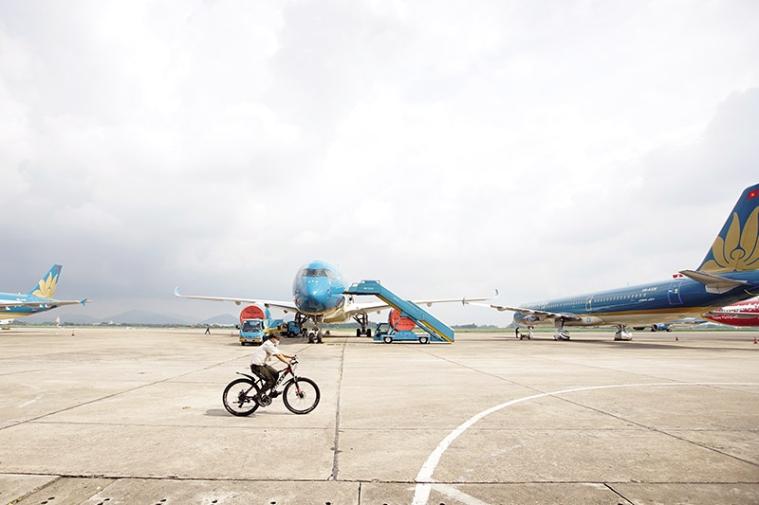Opportunities for private firms to invest in Vietnam’s airports
Investment opportunities in aviation infrastructure from private investors will increase when the Airports Corporation of Vietnam (ACV) prioritizes resources for six key airports.
The Civil Aviation Administration of Vietnam has submitted to the Ministry of Transport a scheme to mobilize social capital for investment in airport infrastructure. This is the third time in the past six months that this scheme has been revised and submitted to competent authorities for approval.
Mr. Pham Van Hao, Deputy Director of the Civil Aviation Administration of Vietnam, said the scheme has been revised based on opinions from central agencies, ministries, People’s Committees of provinces and cities, research institutes, and aviation enterprises.
In the latest scheme, the Civil Aviation Administration of Vietnam still proposes classifying 21 airports managed by ACV into five groups.
Group 1 includes the six key airports of Noi Bai, Da Nang, Cam Ranh, Phu Quoc, Long Thanh, and Tan Son Nhat. These are important international airports which play the role of gathering passengers and cargo to connect to the domestic and international flight network.
Group 2 includes Tho Xuan, Chu Lai, Phu Cat, Tuy Hoa, which are airports with military activities, regular military training, and assets and land in airfields managed by the Ministry of Defense.
Group 3 includes airports in remote areas, mountainous areas, and islands, with a planned capacity of less than 5 million passengers/year by 2030, such as Dien Bien, Na San, Dong Hoi, Pleiku, Buon Ma Thuot, Rach Gia, Ca Mau, Con Dao.
Group 4 includes airports with a planned capacity of more than 5 million passengers/year by 2030, with development potential, capable of attracting investors, and without regular military activities, including: Cat Bi, Vinh, Phu Bai, Lien Khuong, Can Tho.
Group 5 includes new airports such as Sa Pa, Quang Tri, Lai Chau and potential airports such as Cao Bang, Hai Phong (Tien Lang), and a second airport in the capital region.
Regarding the mechanism to mobilize capital aviation infrastructure projects, the Civil Aviation Administration of Vietnam proposed:
Group 1: The Ministry of Transport should arrange investment capital for the airfield; ACV will arrange investment capital for remaining essential infrastructure works; mobilize 100% of social capital for aviation and non-aviation service works in the form of business investment.
Group 2: If the Ministry of National Defense hands over the airfield to the Ministry of Transport or the local government, the agency that drafts the scheme will propose mobilizing social capital to invest in the entire airport in the form of Public-private Partnership (PPP).
Groups 3 and 4: The Civil Aviation Authority of Vietnam proposed that the Ministry of Transport transfer the airport and that ACV transfer the necessary infrastructure works to the local authorities to mobilize investment resources in the form of PPP.
Group 5: The Civil Aviation Administration of Vietnam should recommend mobilizing social capital in the form of PPP and assign the People’s Committees of provinces to be the competent authority to invest in the form of PPP.
ACV is out of breath
According to the master plan for the development of airport system in 2021-2030, with a vision to 2050, which is waiting for approval from authorities, the total demand for investment capital in aviation infrastructure in 2021-2030 is about VND 479,606 billion, including VND 403,106 billion for essential works of airport.
At the end of 2019, ACV reported that it had fully allocated 100% of capital needed for essential works of the 21 airports managed by ACV in the period of 2021-2025. However, according to a report by ACV and the Committee for the Management of State Capital at Enterprises in July 2021, due to the heavy impact of Covid-19, ACV’s expected revenue and profit in the period 2020-2025 will decrease. Due to severe decline, ACV will not have enough resources to invest in the 21 airports managed and exploited by ACV.
“Therefore, in the period of 2021-2025, ACV will have to prioritize investment in Long Thanh airport in phase I and Tan Son Nhat, Noi Bai, Phu Bai, and Dien Bien airports,” Mr. Hao said.
The Civil Aviation Administration of Vietnam proposes that the Ministry of Transport ask for the Government’s guidance on orientation to mobilize social capital for investment in aviation infrastructure.
It is estimated that in the period of 2021 – 2030, the total shortfall of capital that needs to be mobilized from social capital to invest in aviation infrastructure is up to 204,615 billion VND.
Mai Lan
https://vietnamnet.vn/en/acv-%C3%A6%C2%B0u-tia%C2%AAn-ngua%C2%BB%E2%80%9Cn-la%C2%BB%C2%B1c-6-sa%C2%A2n-bay-tra%C2%BB%C2%8Dng-ya%C2%BA%C2%BFu-pha%C2%BA%C2%A7n-ca%C2%B2n-la%C2%BA%C2%A1i-danh-cho-nha-%C3%A4%E2%80%98a%C2%BA%C2%A7u-t%C3%A6%C2%B0-t%C3%A6%C2%B0-nha%C2%A2n-2007519.html


 Thailand
Thailand




